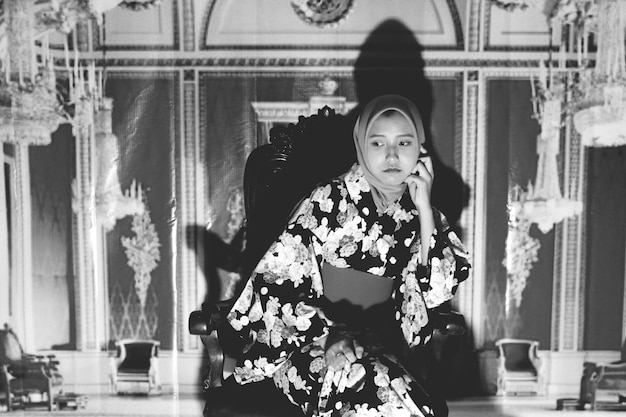Is Melodrama Making a Comeback? Latest Trends in K-Drama Movies

Melodrama in K-drama movies is showing signs of resurgence, with recent films exploring complex emotional themes and character-driven narratives reminiscent of classic melodramas, blending modern storytelling with traditional sensibilities.
Is melodrama making a comeback in K-drama movies? Recent releases suggest a renewed interest in deeply emotional and character-driven stories. Let’s explore the latest trends and see if this beloved genre is indeed experiencing a revival.
The Enduring Appeal of Melodrama
Melodrama, a genre known for its heightened emotions, intricate relationships, and often tragic narratives, holds a special place in the hearts of many viewers. But what makes it so captivating, and why does it seem to resurface time and again?
The Roots of Melodrama in K-Dramas
The roots of melodrama in Korean dramas can be traced back to the historical context of Korean society. These dramas often mirror societal changes, exploring themes of love, loss, and redemption.
The traditional elements provide a canvas for exploring the complexity of human emotions, offering viewers an emotional release and cathartic experience.

Modern Twists on Classic Themes
While staying true to the genre’s core, present-day melodramas infuse modern elements to create new exciting plots with a contemporary twist. This evolution has allowed melodrama to connect with a younger audience.
- Exploration of social issues: Addressing prevalent societal challenges.
- Complex character arcs: Involving a change to personality throughout the story.
- Breaking of gender stereotypes: Promoting more empowered, diverse leads.
Through this evolution, melodrama manages to address contemporary social issues and connect with the current audience, ensuring its relevance in modern storytelling.
Melodrama continues to stand the test of time through a blend of traditional ideals and modern societal challenges. The ability to evoke deep emotions and connect with audiences on a personal level ensures this genre remains relevant. Recent K-Drama movies offer a new perspective, keeping melodrama fresh and engaging.
Factors Behind the Potential Melodrama Comeback
Several factors may be contributing to the resurgence of melodrama in K-drama movies. Understanding these factors can help explain why this genre, once considered old-fashioned, is attracting renewed attention.
Nostalgia and Comfort
Nostalgia for simpler times and familiar storylines could be driving the comeback. Melodramas are a means of comfort and familiarity for many viewers.
The desire to experience intense emotions and familiar stories can be a powerful motivator, especially in times of uncertainty.
A Reaction to Genre Saturation
The market is saturated with lighter, formulaic content. There’s a need for something to cut through the noise, and melodrama provides that emotional resonance.
- Original narratives: Melodrama is a break from repetitive content.
- Emotional depth: Filling a longing for meaningful narratives.
- Heightened emotions: Melodrama offers intense emotional scenarios.
The comeback may be driven by the desire for more profound, emotion-driven experiences that lighter content struggles to provide.

Seeking Emotional Depth
Many viewers are increasingly seeking stories that delve into emotional and psychological complexities. Melodramas engage viewers on a more profound emotional level due to the genre’s reputation for exploring human emotions.
The genre provides an avenue for escapism and catharsis, allowing viewers to fully immerse themselves and feel intense emotions in a safe, controlled environment. This immersion results in a deeply personal connection.
The potential revival can be attributed to nostalgia, a need for content that cuts through noise, and a growing desire to engage with emotionally complex and immersive narratives.
Key Elements Defining Modern Melodramas
Modern melodramas are not simple repeats from previous eras. They come with several key characteristics. These elements set them apart and highlight their appeal, which creates stories that address modern audiences while maintaining the deep emotion.
Character-Driven Narratives
Modern melodramas often focus on character development. This contrasts with plot-driven stories. Modern approaches allow for more personal and emotionally involved films.
These character-driven narratives emphasize the importance of understanding characters and the emotional complexities that determine their actions. This invites viewers to engage more deeply and create connections.
Complex Relationships
Modern melodramas explore complicated relationships, which allows the stories to be more relatable to real-world issues. This approach makes the stories more poignant.
The use of complex relationships creates a network of interpersonal dynamics that invite viewers to explore the complexities of love, kinship, and conflict. These nuanced portrayals build on the richness of modern melodrama.
Moral Ambiguity
Moral ambiguity is a defining hallmark of modern melodramas. There is no simple case of good or bad due to the complicated moral compass.
- Nuanced Characters: Characters are neither purely good nor evil.
- Ethical Dilemmas: Forces characters to make hard decisions.
- Social Commentary: Reflecting the gray areas of modern life.
By delving into the moral complexities of their characters and storylines, modern melodramas challenge viewers to consider multiple perspectives, fostering a more profound and introspective viewing experience.
Modern melodramas feature character-driven narratives, complex relationships, and moral ambiguity through nuanced portrayals. These elements reflect current societal issues and resonate with audiences seeking more profound and introspective stories.
Recent K-Drama Films That Showcase Melodrama Comeback
Several recent K-drama films stand out, emphasizing the resurgence of melodrama. These films showcase the genre’s potential in storytelling and emotional depth.
“Be With You” (2018)
“Be With You” is a remake of a Japanese novel of the same name. It’s a melodrama that deals with many emotional themes, with a significant focus on the relationships that build us.
The film’s popularity highlights an ongoing appreciation for stories that resonate in sentimentality and emotional depth, solidifying melodrama’s lasting power.
“Tune in for Love” (2019)
“Tune in for Love” is a gentle, nostalgic melodrama that explores themes of love, fate, and the power of connection through music. The setting of a radio station adds a layer of retro charm.
- Emotional depth: Dealing with personal and societal issues.
- Nostalgic appeal: Provides viewers with familiarity and comfort.
- Character-driven: Centered on the protagonists’ growth and choices.
“Tune in for Love” demonstrates how melodrama can softly tug at heartstrings, reminding viewers of the beauty in everyday moments.
“Josee” (2020)
“Josee” is another drama that reinterprets a Japanese short story. It delves into a very personal and sensitive relationship. “Josee” brings to light questions about independence, connection, and limitations.
With its bold and sensitive approach, “Josee” exemplifies how modern K-drama melodramas are pushing boundaries. They offer a blend of romance, drama, and a desire to connect.
These films highlight melodrama’s versatility, as well as the ability to blend traditional elements. The film’s approaches continue to resonate in sentimentality and emotion with the genre’s lasting power.
The Impact of the Comeback on K-Drama Industry
The revival of melodrama can have a significant impact on the K-drama industry. It offers new creative opportunities, expands genre diversity, and reshapes audience expectations.
Encouraging Diversity in Storytelling
The comeback supports a more comprehensive scope of storytelling. Melodrama’s resurgence invites an array of narratives. The diversity helps keep the K-drama industry fresh.
The genre diversity enables creators to connect with a broader audience, enhancing the richness of content available.
Attracting a Broader Audience
Melodrama is a means of attracting a varied set of followers. With nuanced storytelling, this can draw in those seeking emotion.
Melodrama becomes a gateway for those less familiar with the K-drama industry. This gateway introduces fresh perspectives and themes that capture global interest.
Creative Experimentation
The recent trend of melodrama promotes an environment of creative expression. The emotional exploration and complexities within the story spark unique productions.
- Blending Genres: Creates hybrid storytelling.
- Complex Narratives: Encourages deeper emotional resonance.
- Character Innovations: Sparks more nuance driven characters.
Creative experimentation allows K-drama productions to venture into unique and boundary-pushing projects. This sets the standard for future innovations.
The revival fosters diversity in storytelling, attracts a wider population, and sparks creative opportunities. All these traits combine for a more sophisticated industry that engages both national and international viewers.
Future of Melodrama in K-Drama Movies
Looking ahead, the future of melodrama appears promising and ripe with potential. Several paths may shape its evolution.
Integration with Other Genres
Genres seamlessly blended into melodramas can create hybrid stories that bring in a modern audience. With a dynamic combination, the stories can bring an amazing experience.
The combination of emotional depth and different genre elements can result in new and captivating stories.
Focus on Socially Relevant Themes
Touching on social topics makes dramas resonate in present times and also increases their value and impact. Social consciousness is important.
By integrating socially relevant material, melodramas can spark conversations, educate audiences, and foster solidarity.
Global Appeal
Melodramas highlight common human experiences that resonate across cultures. This gives content a universal charm that goes beyond borders and languages.
- Universal Themes: Touching on love, kinship, and redemption connects people from different backgrounds.
- Localization Efforts: Offering subtitles and dubs makes content accessible.
- International Partnerships: Cooperation promotes broader distribution.
By appealing to universal emotions, melodramas can continue to have a significant reach.
The future of melodrama in K-drama movies involves integrating it with other genres, a greater focus on socially relevant themes, and appealing to a global audience. This allows for captivating stories appealing to a wide range of viewers.
| Key Point | Brief Description |
|---|---|
| 😢 Emotional Resonance | Melodramas offer intense emotional experiences, connecting deeply with viewers. |
| 🔄 Modern Twists | Contemporary melodramas address social issues and break gender stereotypes. |
| 🌍 Global Appeal | Universal themes like love and loss allow melodrama to connect with diverse audiences. |
| 🎭 Character Depth | Melodramas focus heavily on detailed character development and moral ambiguity. |
Frequently Asked Questions
▼
K-drama melodramas are characterized by heightened emotions, complex relationships, and sentimental or tragic narratives. These dramas often explore themes of love, loss, and redemption in a dramatic fashion.
▼
Melodramas are experiencing a resurgence due to audience nostalgia, a desire for deeper emotional experiences, and as a contrast to the lighter, more formulaic content frequently available. Many seek out emotional stories.
▼
Modern K-drama melodramas incorporate socially relevant themes, break gender stereotypes, and feature complex character arcs. Compared to older melodramas, they engage with contemporary issues.
▼
Notable examples include “Be With You” (2018), “Tune in for Love” (2019), and “Josee” (2020). These films are celebrated for their emotional depth, and nostalgic sentiments.
▼
Melodramas encourage diversity in storytelling, attract a broader audience, and promote creative experimentation. This leads to a more refined audience and a global exposure.
Conclusion
The potential comeback of melodrama in K-drama movies marks a shift in storytelling preferences, emphasizing the desire for emotional depth and exploration of complex relationships. As the genre evolves by integrating modern themes and attracting a global audience, it promises a dynamic future, enriching the K-drama industry with profound and heartwarming narratives.





